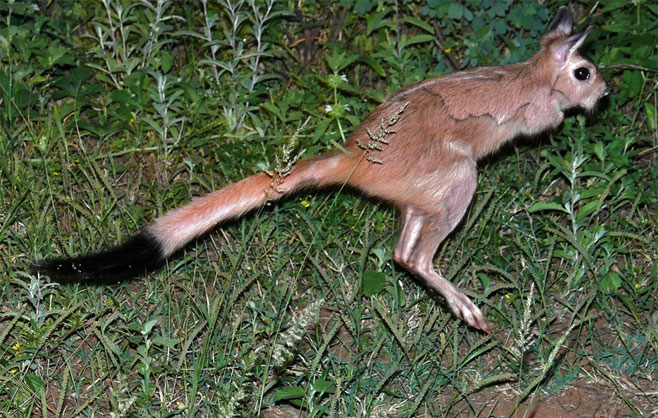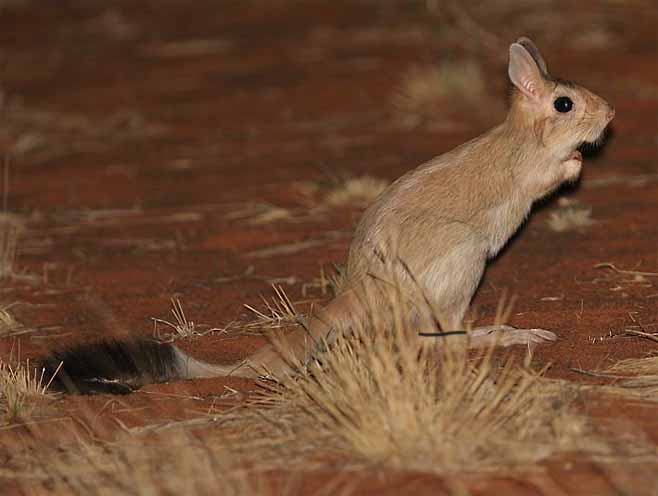|
Pedetes capensis
(Springhare)
springhaas [Afrikaans]; Springhase [German]; liŤvre
sauteur [French]; kamendegere [Swahili]; umahelane [isiNdebele]; indulane,
isandlulane [isiZulu]; tshipjane [Sesotho]; ntlolÍ, ntlolane, matlolane, tshipo,
matsipane [Setswana]; nhire, gwidzu [Shona]; ndlulwane [siSwati]; khadzimutavha
[Tshivenda]; sinkuyu [Lozi]; unkuyu [Yei]; ╪Gōb
[Nama] [Damara]
Life
>
Eukaryotes >
Opisthokonta >
Metazoa (animals) > Bilateria > Deuterostomia >
Chordata > Craniata > Vertebrata (vertebrates) >
Gnathostomata (jawed vertebrates) > Teleostomi (teleost
fish) > Osteichthyes (bony fish) > Class:
Sarcopterygii (lobe-finned fish) > Stegocephalia
(terrestrial vertebrates) > Reptiliomorpha > Amniota >
Synapsida (mammal-like reptiles) > Therapsida > Theriodontia
> Cynodontia > Mammalia (mammals)
> Placentalia (placental mammals) >
Euarchontaglires > Glires > Rodentia (rodents) >
Sciurognathi > Family: Pedetidae
 |
|
Pedetes capensis, Letaba Rest Camp (night
drive), Kruger National Park, South Africa. [photo
Bernard Dupont ©] |
|
 |
|
Pedetes capensis
(Springhare), Tswalu Kalahari Reserve, South Africa. [photo Trevor
Hardaker ©] |
A distinctive species with its hindlegs adapted for jumping.
It looks not unlike a kangaroo in habit but is in fact a rodent. It inhabits
areas that are moderately open with short grass and it also needs compacted
sandy soil in which to make its burrow. It is entirely nocturnal and feeds
exclusively on vegetable matter, particularly grass, grass roots, and seeds.
Identification
The springhare is a large rodent that resembles a kangaroo,
its common name is derived from its locomotion, which consists of a series of
bounds and hops. It has long powerful hindlegs and short, lightly built
forelimbs. The hair on the upper parts is long and straight, and yellowish,
cinnamon to reddish fawn in colour. The underparts are white to cream-fawn. They
have short round rabbit-like heads with large eyes and a protruding nose. The
ears are long, upright and pointed. The senses of sight, smell and hearing are
all well developed. The hindlimbs have 3 large nails and the front limbs have 5
long, pointed claws for digging. The tail is long and bushy with a distinctive
black tip, and helps with balance during jumping.
Size
Total length 75 - 85 cm; weight range 2.5 – 3.8 kg.
Distribution and habitat
Widely distributed in southern Africa, but more-or-less
absent from the Western Cape. It also occurs in East Africa. Inhabits regions
where there is at least some compacted sandy soil where they can dig their
burrows. They also prefer low vegetation cover - not long dense grass and
woodland. They are often found on the perimeter of fossil lake beds and flood
plains.
General behaviour
Springhares are solitary and entirely nocturnal, spending
the day in well-drained sandy burrows, sheltering from the heat and potential
predators. Each burrow system has several escape routes but no chambers, it is
occupied by a single animal or a mother and her baby. Springhares often block
the entrances to their burrows with loose soil to prevent access by predators
such as snakes and mongooses.
Food
They eat a grass, grass roots, seeds and other plants,
including cultivated crops. They are mainly grazers and are selective feeders,
eating selected portions of the plant and discarding the rest. Food is
manipulated with the front limbs and directed into the mouth to be cut and then
finally ground with the cheek teeth. In the wild springhares do not need to
drink water as they obtain their water requirements from their food.
Predators, parasites and commensals
The springhare is small enough to be killed by snakes,
owls, and mongooses yet large enough to be of interest as prey to larger
carnivores, such as lion, leopards, wild dog and man. While it is adapted for an
arid environment it is also well adapted to avoid predators. When it is chased
by a predator it can leap 3-4 m. If it is captured it will try to bite with its
large incisors or kicks out to rake the animal with the large sharp nails of the
hindfeet. While feeding they often move on all fours.
Reproduction
The gestation period period is 72-82 days. One baby is born
at a time throughout the year and females will usually average 3 pregnancies per
year. The pups are fully furred at birth and open their eyes within 2-3 days.
They emerge from in the burrow for the first time at 6-7 weeks. When they emerge
they are only slightly smaller than an adult, start eating grass, and are weaned
quickly.
Life span
12-15 years.
Conservation
An increase in hunting activity that has reduced their
populations by an estimated 20% over the last decade. They are the most common
wild animal in the human diet and are hunted for food, and their skins for
clothing and rugs. They are an essential resource for bushman communities in
Botswana. The long sinew in their tails is also used as thread for skins.
Springhares can do serious damage to crops like maize, wheat and groundnuts by
digging the planted seed from the soil and raiding established crops. Obviously
this brings them into conflict with crop-producing farmers who regard them as
pests. While they may benefit from the absence of their natural predators (lion,
hyaena, leopards) over most of their range, they are also threatened by the loss
of suitable habitat in areas where there is heavy grazing by livestock.
Text by Denise Hamerton |
